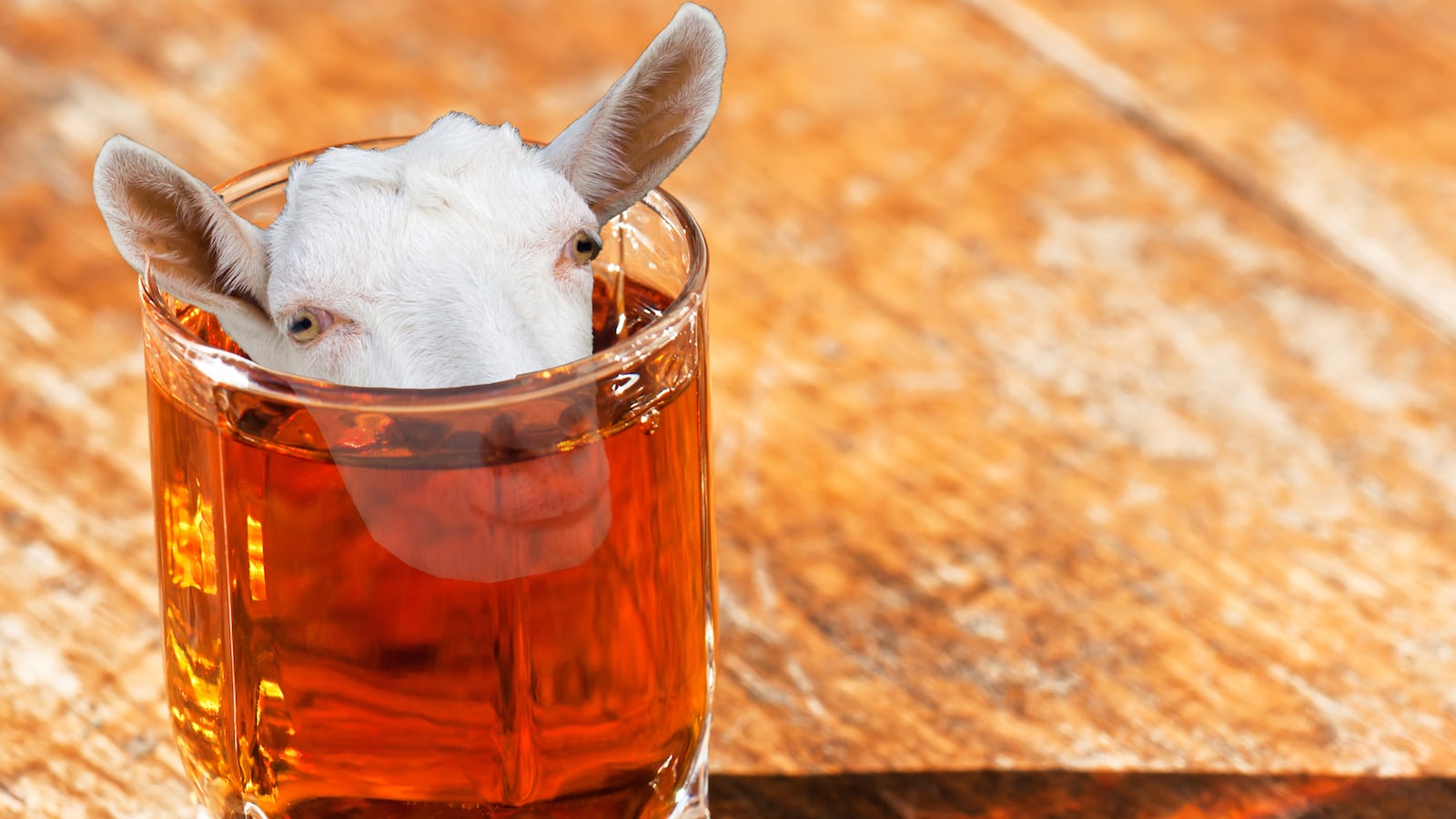“He got within about six feet of it before he started vomiting everywhere!” Bryan Davis told me with a hearty laugh.
He was talking about one of his buddies, a rum critic who had been given rare access to one of Jamaica’s secret dunder pits. If you haven’t heard about dunder pits before, you’re about to, with a new, avant garde rum, Santeria, poised to take over America’s burgeoning rum scene.
It was in reading Adam Rogers’s Proof: The Science of Booze where I’d first heard that obscure term. A “dunder pit” was essentially a hole in the ground, often deep in the jungle, that Caribbean rum-makers threw their distillery waste into—fruit, molasses, sometimes even dead bats and rotting goat heads.
“Dunder pits look as disgusting as you’d imagine,” adds Rogers.
Once this pit underwent bacterial fermentation and became something they called “muck,” the distillers would put a portion of it back into their fermentation tank. By the end of the fermenting process, the gross scent of muck would be gone and the rum would come out smelling like a fruit basket.
Ancient rum-makers might not have understood why this all occurred, but they knew the unbearably awful-smelling dunder pit was what was surely responsible for turning their rum into highly-flavorful alcohol.
“The smell of these pits is indescribable,” notes renowned rum expert Rene van Hoven, who once saw one in Martinique. “The pit smells like hell and I think you would die if you fell in. I call them swimming pools of death!”
To be clear, these ancient dunder pit are most certainly still in use in the rum-making world, specifically in Jamaica.
Perhaps not surprisingly, though, if you visit any Jamaican rum websites, you won’t see the word “dunder” ever mentioned. Not on Hampden Estate’s website (even in the “distillery” section), nor J. Wray & Nephew’s (“The Production Process”), nor Smith & Cross’s either.
Likewise, in reaching out to these distilleries to learn more about their dunder pits, not a single one was willing to talk about them (“Please refer to the holding area…as ‘fermentation pits,’” Hampden Estate’s PR woman told me). Heck, try to even find a Google Image of a dunder pit.
“I think they’re afraid that, to our Judeo-Christian world, they’ll look like ancient voodoo priests,” Davis laughs.
I’d been first introduced to Davis while drinking rum cocktails at ABV in San Francisco. A geeky bartender told me about a small distillery in Monterrey, California trying to make rums using that ancient, dunder pit concept.
How could this be?
How could this be…legal in America?
As the master distiller at Lost Spirits Distillery, Davis is perhaps the most inventive booze maker in all America at the moment. Though, Davis doesn’t even really consider Lost Spirits a distillery.
“We’re a bio-tech, that’s what we essentially are,” he matter-of-factly tells me. Whatever the case, so far as I can tell, they are the only place in this country actually using dunder pit techniques. (Though attempting your own tiny dunder pit has become a bit of a badge of honor in the home rum-making community.)
Davis is one of the more interesting men I’ve ever talked to. He called me from the site of his rapid-aging alcohol reactor prototype, set in a field of artichokes in case it explodes during testing.
“I have a really weird history,” he tells me with a laugh (he’s always laughing). He has an art degree and started off building the “atmosphere” for amusement park rides. W
hen he was 25, he and his girlfriend/business partner Joanne Haruta started an absinthe distillery in Spain named Obsello. (“The absolute stupidest thing possible!” Bryan again laughs.)
It was nearing bankruptcy after just two months when they got a lucky break—the U.S. decided to legalize absinthe and distributors were now scrambling to find product to import. Obsello eventually became the #4 overall absinthe in the marketplace before Davis and Haruta sold it off.
In 2009 the pair, now in their late-twenties, moved back to America to create another craft distillery on some farm property Haruta’s parents owned on the shores of the Pacific Ocean.
But what product? Vodka and gin had already flooded the market and what everyone was craving were aged products, especially whiskeys and rums.
Davis had recently grown intrigued by a weird spirit called Rum Fire from the aforementioned Hampden Estate.
“It’s wild because they use this rotted yeast-rich foam called dunder as part of the fermentation process,” he told Kevin Chan of the NY Loves Whiskey blog back in 2013. “I don’t know if I like it, but I’m fascinated by the process.” No surprise, this inveterate tinkerer wanted to see if he could recreate that effect and modernize the dunder pit.
“Bacteria spores live inside the soil of dunder pits,” Davis tells me. “Carboxylic acids. That’s the rotting smells of the dunder pit. We’re repulsed by it because we know it’s the smell of bacteria fermenting, and some of that bacteria can kill us.”
But, of course, as the Jamaicans have shown us, there is clearly a way to make dunder not just safe for consumption, but also delicious.
What Davis needed to do was figure out the tricky process of forcing yeast to carry out something called esterification—chemically bonding stinky carboxylic acids to alcohol in order to create flavorful esters. Esters are the compounds that gives fruits, flowers, and spices their unique aromas.
The most coveted Jamaican-style rums have super high ester counts, typically in the three-hundred to six-hundred range (per million parts alcohol), much higher than the best aged whiskeys even. Hampden Estates claims their rums have up to 1600 esters. “Like a flavor bomb got detonated on your tongue,” Davis tells me of Rum Fire.
“I figured, this can’t be that hard, Jamaican distilleries have been doing this for centuries. It turns out that yeast can convert acids to esters under certain conditions. I just needed to figure out how to help the yeast do their job by recreating those conditions.”
More specifically, and perhaps tricky, Davis wanted to be able to create those conditions of dunder pit, but without making a dirty hole in the ground full of rotten fruit and decomposing animal carcasses.
“I would do voodoo…in the lab,” he recalls thinking.
The acidity inherent in Jamaican dunder pits is created by the bacteria Clostridium saccharobutyricum; that’s Jamaican rums’ signature flavor.
For an American itching to try a 100% dunder pit rum, sniff and then sip a bottle of J. Wray & Nephew or Smith & Cross and you’ll instantly notice that unique, really funky, banana-y aroma.
You’ll even detect it in mass market Jamaican rums like Appleton Estates or Myer’s Rum, both of which have just a hint of dunderfied rum blended in for aroma. Most mass market rums are blends, and the vast majority of rums you’ve had in your life probably had just a hint of dunder pit rum in them.
“So I started thinking, gosh, if you just changed that bacteria [Clostridium saccharobutyricum], you could produce whatever flavor you want,” Davis recounts. “Flavors not even able to be made by nature. You could basically engineer the entire thing!”
Instead of the typical Clostridium, Davis first wanted to use cheese-making bacteria to produce lactic acid—“It has an ester aroma we identify with creamy dairy,” he notes—adding the bacteria to a bucket with mashed-up, overripe bananas to create a highly productive fermentation. (When I asked “Why bananas?” he told me, “I could have really used anything—even rotten ground beef if I wanted!”)
Amazingly, his new-wave process was able to yield more carboxylic acid than several years in a legitimate dunder pit.
Eventually, the faux-muck he created was combined with high-quality, 100% Grade A baking molasses and evaporated sugarcane juice, fermented, then distilled. The result was called Navy Style Rum.
“It had all the right stuff, but all the wrong concentrations. Light on the fruit side, heavy on the smoke and honey. It was good though and developed a cult following because it was a product nature literally couldn’t make. So that was new and exciting.”
Next, Davis wanted to do the opposite and make a “fruit bomb.” He opted for a bacteria that would produce butyric acid, which actually smells like vomit, but when bonded to alcohol forms intense pineapple aromas. So pineapple-y in fact, that this release, called Polynesian Style Rum, became a massive hit at tiki bars. As far as Davis know, it has the highest amount of fruity, carboxylic esters ever detected in an American rum.
His “dunder” bucket had worked!
Lost Spirits’ high-ester rums are phenomenally unique, dark, funky, and with a super intense flavor profile. They’ve already won a gold medal at the Los Angeles Craft Spirits Award and even won Best in Show at last year’s Miami Rum Festival.
Still, good luck getting to try anything Davis makes—he only produces a few barrels of product per year, mainly to test his theories and technologies.
Davis’s success might make you wonder, though, why aren’t other American rum distillers going the dunder route? Would a legitimate dunder pit even be legal in this country?
“Depends…because, technically speaking, the local health inspector is going to make the call,” Davis tells me. “Odds are, though, unless you’re very rural, they’re going to shut you down. You’d be stinking up the whole town! Not to mention, since it would be full of Clostridium, you’d probably have Homeland Security showing up thinking you’re trying to isolate the botulism toxin!”
Davis just teamed with an upstart South Carolina distillery named Rational Spirits to release some ten thousand bottles of “Santeria,” America’s highest ester rum yet and perhaps the first chance for most Americans to ever try a 100% dunder pit-made rum. No rotting goat’s heads included though.






